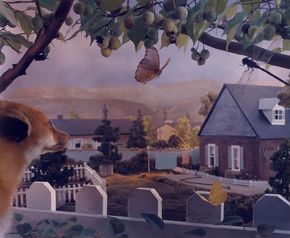Always Greener: Seeing and Seeking Suburbia—Selections from the Museum’s Collection August 21, 2018–February 3, 2019

Gregory Crewdson, Untitled, from the series Natural Wonder, 1992, chromogenic print, the Museum of Fine Arts, Houston, gift of Joan Morgenstern in honor of Anne Wilkes Tucker on the occasion of her retirement. © Gregory Crewdson
Alexandra Avakian, Tufaha Baydayn, a Lebanese American, fled Lebanon’s civil war in the 1970s. Dearborn, Michigan, 2002, inkjet print, the Museum of Fine Arts, Houston, gift of the artist. © Alexandra Avakian
Trenton Doyle Hancock, Flower Bed, 2001, graphite, ballpoint pen, roller pen, watercolor, and incising on wove paper, the Museum of Fine Arts, Houston, Museum purchase funded by Lester Marks. © Trenton Doyle Hancock / Courtesy James Cohan Gallery, New York/Shanghai
Cindy Sherman, Untitled Film Still, 1979, gelatin silver print, the Museum of Fine Arts, Houston, Museum purchase funded by Mr. and Mrs. Harry B. Gordon. © Cindy Sherman, courtesy of the artist and Metro Pictures, NY
Robert Rauschenberg, Untitled, 1979, offset lithograph in colors, the Museum of Fine Arts, Houston, gift of Karen Luik in honor of Maggie Olvey in recognition of her service to the works on paper collection, 1981–1993. © Estate of Robert Rauschenberg
Philip Guston, published by Gemini G.E.L., Room, 1980, lithograph on wove paper, the Museum of Fine Arts, Houston, bequest of Edward R. Broida. © Estate of Philip Guston, courtesy McKee Gallery, New York
Isca Greenfield-Sanders, published by Paulson Fontaine Press, Red Suit Diver, from The Swimming Pool Etchings, 2006, etching and aquatint in colors on wove paper, the Museum of Fine Arts, Houston, gift of Karin and Timothy Greenfield-Sanders in honor of Edwin Cohen. © Isca Greenfield-Sanders
Mark Bennett, Home of Steve and Barbara Douglas, North Hollywood, CA, 1987, fiber-tipped pen and ink on printed drafting paper, the Museum of Fine Arts, Houston, gift of private collector, Los Angeles. © Mark Bennett
Following World War II, Americans poured out of cities and into suburban housing developments on a wave of economic prosperity. The desire to own a new home on a quiet street was contagious, and by 1950 a quarter of the U.S. population lived in the suburbs. Today, more than half of all Americans do.
As the suburbs have grown, so has their place in popular culture. Movies, TV, literature, and the arts show suburbia not only as the American Dream but also as a bed of isolation, segregation, frustrated femininity, and compromised masculinity. Such complex and sometimes contradictory representations reveal the diverse experiences of people whose everyday lives diverge from the seemingly uniform neighborhoods they call home.
Navigating suburbia’s varied and evolving identities, the prints, drawings, and photographs on view in Always Greener form a rich portrait of suburban life. Suburbia’s grass may not always be greener, but it provides fertile ground for artistic exploration. Diane Arbus, Philip Guston, Trenton Doyle Hancock, Robert Rauschenberg, Cindy Sherman, and Larry Sultan are just a few of the artists represented.
Always Greener: Seeing and Seeking Suburbia—Selections from the Museum’s Collection | August 21, 2018–February 3, 2019
This exhibition is organized by the Museum of Fine Arts, Houston.
